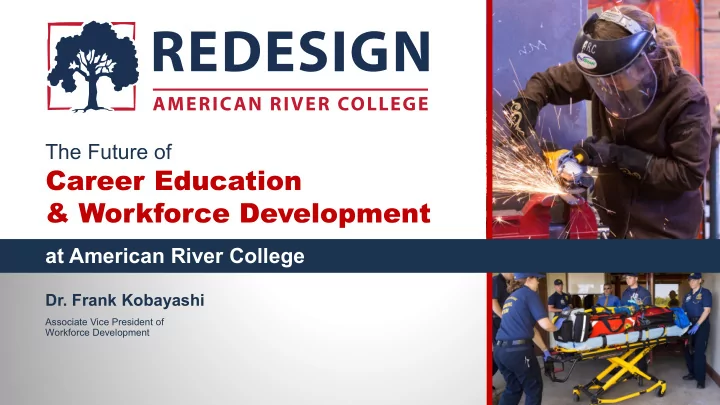

The Future of Career Education & Workforce Development at American River College Dr. Frank Kobayashi Associate Vice President of Workforce Development
46 Career Education Programs
Strong Workforce Stars Earnings ↑ 50% or more Regional living wage ↑ 70% or more Employed in ↑ 90% or more field of study
4 Gold Star Career Education Programs
Dual Enrollment
AB 288: Dual Enrollment • Expanding opportunities • Underrepresented students • Seamless pathways from high school to community college
Dual Enrollment Pathways to ARC Automotive Technology Diesel Technology (San Juan High School) (Rio Linda High School) Diesel Technology Design Technology (Highlands High School) (San Juan High School) = 240+ students
Highlands High School
Apprenticeship
Union Partners • Carpenters Training Committee for Northern California • Field Ironworkers Apprenticeship & Training Program • Northern California Valley Sheet Metal Industry • Plumbing and Pipefitting Industry, Sacramento and Yolo District • Sacramento Area Electrical Apprenticeship
Mark Fuchs Executive Director Carpenters Training Trust Fund for Northern California Carpenters Training Committee for Northern California
What is the future of Career Education and Workforce Development?
What is the future of Career Education and Workforce Development? • The Flexible Workforce • Automation • Virtual/Augmented Reality and Immersive Learning • The Internet of Things • Skilled Worker Shortage & Re - Skilling Incumbent Workers
Design Principles The need for flexible learning space that The need for learning space that mimics allows for cross disciplinary and reflects the industry collaboration. The need to consider disruptions such as virtual reality, robotics, AI, and the Expanding the “Work and Learn” Model. Internet of Things. Using the lens of “Lifelong Learning” as The need to be responsive to or the continuum of Workforce education. predictive of employer needs.
Automation Changes Implication Robotics and AI automating tasks Re-skilling done by people What skills will be In-Demand? Highest Probability of Automation • Creative skills • Office and Administrative • Social skills Support Occupations • Complex physical skills • Production Occupations • Technological skills • Food Preparation
The Design HUB
Virtual/Augmented Reality and Immersive Learning Changes Implication • • Decreased need for brick/mortar Simulations • • Decreased need for equipment Virtual learning
Skilled Worker Shortage & Re-Skilling Incumbent Workers Changes Implication Need for Re-Skilling • Stackable certificates Shortage of skilled workers • Work and Learn Model • Responsive to Industry • Predictive of Industry
The Internet of Things Implications Changes • Data being collected • The threat to data and the constantly need for Cyber Security • Internet of Things has • Interconnection of previously potential to automate, adapt, separate academic disciplines and personalize the entire learning experience.
Intersectionality of Our Work • National Center of Academic Excellence in Cyber Defense • K- 12 Strong Workforce • Community College Strong Workforce • Improving Online CTE Pathways Grant Application • Apprenticeship
The Design HUB
Thank You
Recommend
More recommend